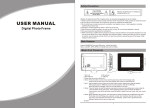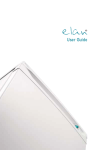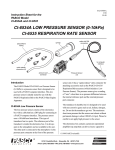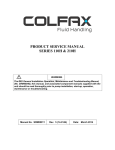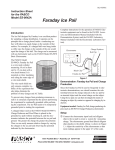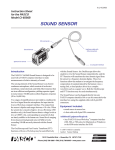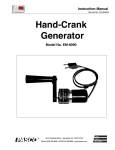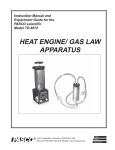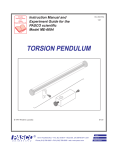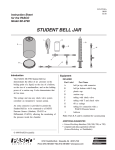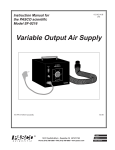Download PASCO Specialty & Mfg. CI-6532A User's Manual
Transcript
012-06859B 10/98 $1.00 Instruction Sheet for the PASCO Model CI-6532A PRESSURE SENSOR - ABSOLUTE (0 TO 700 kPa) cable with DIN connectors syringe to computer interface PA 7 P D 0 R R 0 E S Y kP S S C UR AI a C O E R M O N PA N PO O AX R EC RT NL T T M Y N O A O R T . 6 : IN 40 G -0 21 polyurethane tubing A 32 5 -6 CI RE SU R ES SO a R P EN0 kPTE) S - 70 LU quick release connectors (4) 0 SO B (A pressure port connector Introduction The PASCO Model CI-6532A Pressure SensorAbsolute is designed to be used with a PASCO Science Workshop® computer interface. The CI6532A includes the pressure sensor unit, extension cable with 8-pin DIN connectors, quick release connectors, polyurethane tubing, and a syringe. The pressure sensing element in the pressure sensor unit has two pressure ports. One port is connected to the atmosphere via the pressure port connector at the front of the pressure sensor unit. The other port is internal to the pressure sensing element and is sealed with a reference vacuum. The sensor element is designed to be used with non-corrosive gases such as air, helium, nitrogen, etc. Do not expose the sensor to liquids. Pressure Sensor unit Equipment INCLUDED • Pressure Sensor (Absolute) unit • quick-release connectors (4) • polyurethane tubing (0.6m) • plastic syringe (20cc, calibrated) ADDITIONAL REQUIRED • computer (PC or Macintosh) • Science Workshop® computer interface • Science Workshop® software version 2.2. or higher Extra parts are available as follows: Item plastic syringe polyurethane tubing quick-release connector © 1998 PASCO scientific Part Number 699-084 640-023 640-021 Pressure Sensor - Absolute (0 to 700 kPa) 012-06859B Table 1 Pressure range comparison kiloPascals inches of Hg mm of Hg Bar 700.00 207.25 5250.4 6.999 101.48 6.908 101.32 30.00 760.0 1.013 14.69 1.000 Range and Resolution pounds/sq in atmospheres The sensor box contains a precision operational amplifier (op amp) that can drive a heavy capacitive load, such as a six meter extender cable (CI-6515). There is a resistor in parallel with the transducer to compensate the sensor for temperature induced variations. The sensor has a negative temperature coefficient (resistance decreases as temperature increases) and the resistor has a positive temperature coefficient. The range of the CI-6532A Absolute Pressure Sensor is between 0 and 700 kiloPascals (or 0 to 6.9 atmospheres). Atmospheric pressure is normally around 101.326 kiloPascals (kPa). Pressure can be measured in many different units (e.g., atmospheres, inches of mercury, millimeters of mercury, kiloPascals, Bar, pounds per square inch). Some equivalent values for pressure are: 1 atmosphere = 30.00 in of Hg (at 16ºC) = 760 millimeters of Hg = 101.326 kiloPascals (kPa) = 1.013 Bar = 1013 milliBar = 14.696 pounds per square inch (psi) Operation Setting up the Equipment 1. Connect the Pressure Sensor unit to analog channel A, B, or C of the Science Workshop computer interface box using the cable with the DIN connectors (Figure 1). Alternatively, the unit can be plugged directly into the analog channel jack. The top of the range of pressure expressed in these equivalent units is as in Table 1. The maximum short-term pressure that the sensor can tolerate without permanent damage is about 1,000 kPa (150 psi). Please be careful to not apply high pressure to the sensor. The output voltage from the sensor is +1.00 Volts when the pressure is 100 kiloPascals (kPa), and the output voltage is linear. Therefore, the output voltage should be +7.00 Volts at the top of the range (700 kPa). The resolution of the sensor is 0.5 kPa (when used with a PASCO computer interface). This resolution translates into other pressure units as follows: Units Resolution inches of Hg 0.148 mm of Hg 3.750 milliBar 5.088 pounds per square inch (psi) 0.072 atmospheres 0.004 (AB0 -700 SO URE SO kP R LU a TE ) CI653 PR 2A SE ESS N ES Y AI a MAX SU R PA CORE PO ON SC NN RT LY O PA EC MA RT TOR: TIN NO G . 64 0-0 21 PR 70 DR0 kP Figure 1 Connecting the amplifier box to the interface box 2 012-06859B Pressure Sensor - Absolute (0 to 700 kPa) connector is free to rotate even when the connector is firmly attached to the port. See Figure 3. 2. Connect the quick release connector to the pressure port connector on the Pressure Sensor unit. The sensor is temperature compensated, therefore changes in room temperature will not interfere with the data. quick release connector Using the Syringe and Quick-Release Connectors The Pressure Sensor is designed for experiments such as those that study the gas laws or for the rate of a chemical reaction by monitoring the increase or decrease in pressure. For example, Boyle’s Law is a classic physics (and chemistry) concept that can be demonstrated using the sensor and the syringe. See Figure 2. pressure port connector tubing Figure 3 Using the quick release connectors Mounting on an Experimental Apparatus tip Use the 1/4-20 threaded connector located on the bottom of the sensor box to secure the Pressure Sensor to an experimental apparatus (Figure 4). The alignment hole fits over an alignment pin included on some PASCO apparatuses. 10 5 quick release connector Push the connector onto the pressure port. Turn the connector clockwise until it “clicks” (less than 1/8 turn). barb tubing alignment hole Figure 2 Using the syringe 1/4-20 threaded connector To connect the syringe to the sensor, cut a short length of tubing (about one inch). Put the “barb” end of one of the quick-release connectors into one end of the short piece of tubing. Put the other end of the tubing over the tip on the end of the syringe. Note: You can lubricate the end of the barb to make it easier to put into the short piece of tubing. Put a very small amount of silicon oil or saliva onto the barb and then wipe the barb with a cloth so there is only a thin layer of lubricant on the barb. Figure 4 Mounting connector and alignment hole Align the quick-release connector with the pressure port connector of the sensor. Push the connector onto the port, and then turn the connector clockwise until it “clicks” into place (less than oneeighth of a turn). The barb of the quick-release 3 Pressure Sensor - Absolute (0 to 700 kPa) 012-06859B Suggested Experiments Other PASCO scientific also produces a Differential Pressure Sensor (Model CI-6533) and a Barometer (Model CI-6531). The Differential Pressure Sensor is similar to the CI-6532A, except that both ports of the transducer are open to the atmosphere. It is designed for experiments where pressure differs from one part of the apparatus to another, such as in a Venturi tube or for a demonstration of Bernoulli’s principle. The Barometer has a range from 800 to 1100 milliBar (24 to 32 inches of mercury). It is designed to be a reliable, accurate pressure sensor for weather studies. It is temperature compensated and has a voltage regulator, so changes in temperature or changes in the computer’s power supply will not interfere with the data. Boyle’s Law (pressure vs. volume) Boyle’s Law is a classic experiment in physics (and chemistry) that can be demonstrated using the sensor and the syringe. Set the syringe to a position such as 15 cc. Connect the syringe to the pressure port connector on the sensor. Take data as you change the volume, beginning with a volume that is greater than your beginning volume (e.g., move the syringe to 20 cc). Continue to take data as you decrease the volume to 15 cc and below. Gay-Lussac’s Law (pressure vs absolute temperature) Gay-Lussac’s Law states that if the volume remains constant, the pressure of a container of gas is directly proportional to its absolute temperature. Set up a sealed container of air by attaching the longer piece of plastic tubing to a stopper in a 125 mL Erlenmeyer flask. Connect the other end of the tube to the pressure port connector. Place the flask in water baths of different temperatures. Record data on how the pressure changes with the temperature changes. Pressure in Liquids Put the end of the longer piece of tubing under water. The pressure reading should increase by 0.0978 kPa (0.02896 in of mercury) per centimeter of depth below the surface. You can also use a “J” shaped tube to study how pressure relates to the difference in heights of the liquid in the two parts of the tube. Studying Chemical Reactions by Monitoring Pressure Many chemical reactions produce gases that can cause an increase in pressure in a sealed container. The pressure change can be used to monitor the rate of the reaction. 4 012-06859B Pressure Sensor - Absolute (0 to 700 kPa) Limited Warranty Note: This instruction sheet was written assuming that the user has a basic familiarity with Science Workshop and has access to the User’s Guide for Science Workshop. Users can gain basic skills by working through the tutorial within Science Workshop. Another useful resource is the Quick Reference Card for Science Workshop. PASCO scientific warrants the product to be free from defects in materials and workmanship for a period of one year from the date of shipment to the customer. PASCO will repair or replace, at its option, any part of the product which is deemed to be defective in material or workmanship. The warranty does not cover damage to the product caused by abuse or improper use. Determination of whether a product failure is the result of a manufacturing defect or improper use by the customer shall be made solely by PASCO scientific. Responsibility for the return of equipment for warranty repair belongs to the customer. Equipment must be properly packed to prevent damage and shipped postage or freight prepaid. (Damage caused by improper packing of the equipment for return shipment will not be covered by the warranty.) Shipping costs for returning the equipment after repair will be paid by PASCO scientific. DIN Connector Specifications 1: analog output (+), -10 to +10 V 2: analog output (-), signal ground 3: (no connection) 5: power ground 6: +12 VDC power 7: -12 VDC power 6 1 8 P D 0 R R 0 E PA SS Y kP S C UR AI a C O E R M O PANN PO O AX R EC RT NL T T M Y N O A O R T . 6 : IN 40 G -0 21 4: + 5 V DC power 7 3 5 4 2 8: (no connection) Address: Phone: FAX: email: web: 5 PASCO scientific 10101 Foothills Blvd. Roseville, CA 95747-7100 (916) 786-3800 (916) 786-8905 [email protected] www.pasco.com Pressure Sensor - Absolute (0 to 700 kPa) 012-06859B 6






